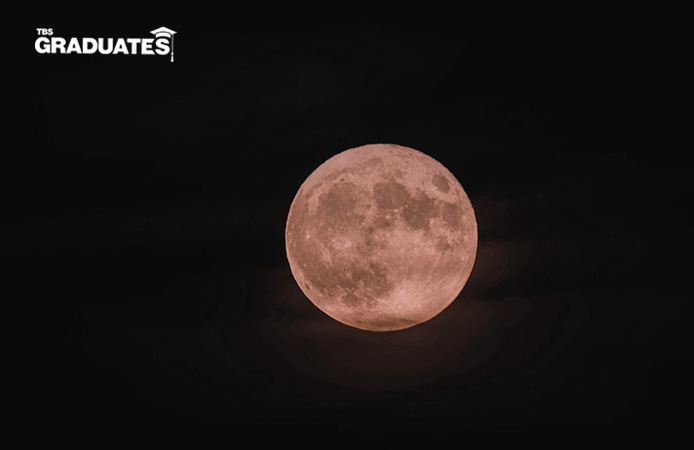Every year we are graced with a pink moon in the night skies of April. Despite its name the moon does not actually change colour and it does not even appear pink, it takes on a mere reddish hue.
So, why do we call it the pink moon, and what scientific wonders lie behind its captivating facade? The pink moon gets its name not from its color but from the wild pink phlox flowers that typically bloom during this time of year in North America. However, the moon itself remains its usual pale, silvery hue. So, what causes this illusion?
The phenomenon can be attributed to the scattering of light in the Earth’s atmosphere. When the moon is low on the horizon, whether rising or setting, its light has to pass through a thicker layer of the atmosphere compared to when it is directly overhead. This thicker atmosphere causes shorter blue and green wavelengths to scatter easily leaving the longer red wavelengths to dominate our view. As a result, the moon appears to take on a warm, reddish or pinkish glow.
The pink moon is anticipated to reach its fullest phase at 7:49pm Eastern Daylight Time on 23 April which is 5:49am on 24 April in Bangladesh, so it is unlikely we will be able to observe the phenomenon.
Not to be disheartened though, the Moon will also be visible on Monday and Wednesday as well.
Throughout history, the Pink Moon has held significance in various cultures around the world. For indigenous peoples of North America, the pink moon served as a marker for the arrival of spring, signaling the time for planting and the emergence of new life. NASA notes that in the 1930s, the Maine Farmers’ Almanac started publishing Native American names for each month’s moon. Following this almanac’ trend, the April full moon became the Pink Moon because the tribes of the northeastern United States called it that. Its appearance was celebrated with rituals and ceremonies, honouring the cycle of nature and the interconnectedness of all living beings. In other cultures, the Pink Moon has been associated with fertility, renewal, and growth. It symbolises a time of awakening, both in the natural world and within ourselves. This annual celestial event reminds us of the cyclical nature of life, encouraging reflection and introspection as we navigate our own journeys. In different parts of the world this event is also known as the Sprouting Grass Moon, Egg Moon, Fish Moon, the Pesach or Passover Moon, the Hanuman Jayanti Festival Moon, and Bak Poya – depending on one’s culture.
Beyond its cultural and historical significance, the Pink Moon also holds scientific importance. Studying the lunar cycle, including events like the Pink Moon, provides valuable insights into the Earth-moon system and our understanding of celestial mechanics. Observing the moon’s phases allows scientists to track its orbit and rotation with precision. This data is essential for space exploration, satellite communication, and understanding the effects of lunar phenomena on Earth’s tides and climate. Additionally, the pink mQoon serves as a reminder of the delicate balance of our planet’s ecosystem. As we marvel at its beauty, we are reminded of the interconnectedness of Earth’s systems and the importance of preserving and protecting our environment for future generations.
While the Pink Moon may not be pink in color, its annual appearance continues to captivate and inspire wonder among skywatchers worldwide with the themes healing, love, and a time to invest in positivity, intimacy and compassion. From its cultural and historical significance to its scientific importance, this astronomical event reminds us of the beauty and complexity of the universe we inhabit. As we gaze upon the Pink Moon, let us not only marvel at its splendor but also reflect on the mysteries it holds and the lessons it imparts about our place in the cosmos.
